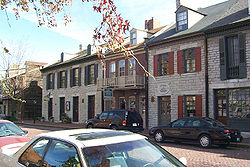St. Charles
Saint Charles (commonly abbreviated St. Charles) is a city in, and the county seat of, St. Charles County, Missouri, United States.[4] The population was 65,794 at the 2010 census, making St. Charles the ninth-largest city in Missouri. Situated on the Missouri River, it is a northwestern suburb of St. Louis.
Founded circa 1769 as Les Petites Côtes, or “The Little Hills” in French, by Louis Blanchette, a French-Canadian fur trader,[5] when the area was nominally ruled by Spain following the Seven Years’ War, St. Charles is the third-oldest city in Missouri. For a time, it played a significant role in the United States’ westward expansion as a river port and starting point of the Boone’s Lick Road to the Boonslick.
St. Charles was settled primarily by French-speaking colonists from Canada in its early days and was considered the last “civilized” stop by the Lewis and Clark Expedition in 1804, which was exploring the western territory after the United States made the Louisiana Purchase.[6] The city served as the first Missouri capital from 1821 to 1826,[7] and is the site of the Saint Rose Philippine Duchesne shrine.[8]
Native American peoples inhabited the area at least as early as 11000 B.C. When European emigres arrived, the area was inhabited by the Ilini, Osage and Missouri tribes.
According to Hopewell’s Romantic Legends of the Missouri and Mississippi: Blanchette met another French Canadian (Bernard Guillet) at the site of St. Charles in 1765. Blanchette, determined to settle there, asked if Guillet, who had become a chief of a Dakota tribe, had chosen a name for it.
- “I called the place ‘Les Petites Côtes’ ” replied Bernard, “from the sides of the hills that you see.”
- “By that name shall it be called”, said Blanchette Chasseur, “for it is the echo of nature — beautiful from its simplicity.”
Blanchette settled there circa 1769 under the authority of the Spanish governor of Upper Louisiana (the area had been ceded by France to Spain under an agreement with Great Britain following French defeat in the French and Indian Wars). He was appointed as the territory’s civil and military leader, serving until his death in 1793. Although the settlement was under Spanish jurisdiction, the settlers were primarily Native American and French Canadians who had migrated from northern territories.
Considered to begin in St. Charles, the Boone’s Lick Road along the Missouri River was the major overland route for settlement of central and western Missouri. This area became known as the Boonslick or “Boonslick Country.” At Franklin, the trail ended. Westward progress continued on the Santa Fe Trail.
San Carlos Borromeo
The first church, built in 1791, was Catholic and dedicated to the Italian saint Charles Borromeo, under the Spanish version of his name, San Carlos Borromeo. The town became known as San Carlos del Misuri: “St. Charles of the Missouri”. The original location of the church is not known but a replica has been built just off Main Street. The fourth St. Charles Borromeo Church now stands on Fifth Street.
The Spanish Lieutenant-Governor Carlos de Hault de Lassus appointed Daniel Boone as commandant of the Femme Osage District, which he served as until the United States government assumed control in 1804 following the Louisiana Purchase. The name of the town, San Carlos, was anglicized to St. Charles. William Clark arrived in St. Charles on May 16, 1804. With him were 40 men and three boats; they made final preparations, as they waited for Meriwether Lewis to arrive from St. Louis. They attended dances, dinners, and a church service during this time, and the town residents, excited to be part of the national expedition, were very hospitable to the explorers. Lewis arrived via St. Charles Rock Road on May 20. The expedition launched the next day in a keel boat at 3:30 pm. St. Charles was the last established American town the expedition visited for more than two and a half years.
State capital and growth
When Missouri was granted statehood in 1821, the legislature decided to build a “City of Jefferson” to serve as the state capital, in the center of the state, overlooking the Missouri River. Since this land was undeveloped at the time, a temporary capital was needed. St. Charles beat eight other cities in a competition to house the temporary capital, offering free meeting space for the legislature in rooms located above a hardware store. This building is preserved as the First Missouri State Capitol State Historic Site and may be toured. The Missouri government continued to meet there until Jefferson City was ready in 1826.
Gottfried Duden was a German who visited in the area in 1824. Travelling under the guidance of Daniel M. Boone, he wrote extensive accounts of life in St. Charles County during his year there. He published these after returning to Germany in 1829, and his favorable impressions of the area led to the immigration of a number of Germans in 1833. The first permanent German settler in the region was probably Louis Eversman, who arrived with Duden but decided to stay. St. Charles, Missouri, is where the first claimed interstate project started in 1956. A state highway marker is displayed with a logo and information regarding this claim, off Interstate 70 going westbound, to the right of the First Capitol Drive exit. Kansas and Pennsylvania also lay claim to the first interstate project.
Government
St. Charles is a charter city under the Missouri Constitution, with a City Council as the governing body, consisting of one member for each of the ten wards, each serving a three-year term.[9] The executive head of the City government is the Mayor for all legal and ceremonial purposes. The Mayor appoints the members of the various Boards, Commissions, and Committees created by ordinance. The current mayor is Dan Borgmeyer; he was sworn in on May 7, 2019.[10]
The City of St. Charles School District has six elementary schools, two middle schools, two high schools, and the Lewis & Clark Tech Building located on Zumbehl Road. St. Charles High School (sometimes called SCHS or simply “High”) was the first built of the two high schools in (year?). St. Charles West (SCW or simply “West”) was added in the late 1970s in response to the city’s growing population. St. Charles West had its first graduation in 1979. St. Charles High School underwent renovation in 1995 to improve both the exterior and interior of the building, as did St. Charles West in 2005, in which a new library and auxiliary gym were built. The city is also served by Jefferson Intermediate, which has all 5th and 6th grade classes, and Hardin Middle School, which has all 7th and 8th grade classes.
St. Charles is the location of a variety of private schools, including Immanuel Lutheran (Pre-K to 8), Zion Lutheran (Pre-K to 8), St. Charles Borromeo, St. Peter’s, St. Cletus (K-8), Academy of the Sacred Heart (founded by Saint Rose Philippine Duchesne, and the site of her shrine), Duchesne High School (formerly named St. Peter High school), and St. Elizabeth Ann Seton-St. Robert Bellarmine (K-8).
Other schools are associated with the Francis Howell and the Orchard Farm school districts, which also serve parts of St. Charles. Many students who live on the southern edge of St. Charles City attend Henderson, Becky David and Harvest Ridge elementary schools, Barnwell Middle, and Francis Howell North High School. To the North, the Orchard Farm School District also serves St. Charles but is based outside the city like the Francis Howell School District, it has two elementary schools, a middle school, and a high school.
Lindenwood University is located on Kingshighway, near downtown St. Charles and St. Charles High. Founded by Major George Sibley and his wife Mary in 1827 as a women’s school named Lindenwood School For Girls, the institution is the second-oldest higher-education institution west of the Mississippi River.[12] The private university is affiliated with the Presbyterian Church. LU is one of the fastest-growing universities in the Midwest and enrolls close to 15,000 students. In 2006 it briefly attracted publicity when People for the Ethical Treatment of Animals staged a small protest against its unusual tuition fee policies.[13] Lindenwood hosts 89.1 The Wood (KCLC), a commercial-free student-driven radio station.
St. Charles was also home to the now defunct St. Charles College (Missouri) (which should not be confused with St. Charles Community College),[14] and Vatterott College.[15]


Coordinates
Country
United States
State
County
Government
• Mayor
Area
[1]
Total
Land
Water
Population
(2010)[2]
Total
Estimate
(2018)[3]
Density
Time zone
Summer (DST)
Area codes
Website
Woemmel is a St. Louis based Plastering company with a concentration in Residential, Commercial, Ornamental, and Plater Repair.

